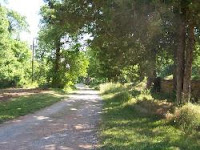 |
| View of Blocker's Artillerymen |
"...I will now endeavor to give you the full particulars of how our gallant little band (Capt. Blocker’s battery) went into the fight, and, as nearly as I can, how we came out of it. On Sunday morning, while marching in line of battle, our battery was ordered, from the rear of the column of artillery, to the front, and, as soon as we discovered the enemy, were ordered to go into battery, which we did. We remained some time in our first position, when we received orders to limber up and change our position for a better one. Again we got well fixed and ready for action, when the enemy opened on us very briskly with their artillery. We responded, and, after firing 4 or 5 rounds, of such luxuries as we had in store for them, we succeeded in silencing heir batteries. We were then ordered to cease firing, which we did, for about three quarters of an hour, when we were ordered to commence firing again. We opened very briskly, with solid shot, spherical, case and shell. After firing 7 or 8 rounds, we were again ordered to cease firing, and await further orders from Gen. Shoup, but, unfortunately, the order for us to recommence firing arrived too late for us to save ourselves, as the enemy had charged and were within 30 paces of our battery. They received the contents of two of our pieces, when we were compelled to fall back, and our battery (save one piece) fell into the hands of the enemy for a short time. Perhaps you may think it strange that we surrendered our battery so quick; but you will not, when I inform you, that we had not a shadow of a support from the commencement to the close of the fight, nor until our battery was lost! Such, however, is the fact, and it pains me to have it to say. The blame must rest where it belongs. * * * * * * * Each and every man stood to his post, until two men and forty three horses were killed, and 11 brave men severely wounded. Eleven men are missing, and, no doubt, killed or captured by the enemy. The enemy advanced upon us with their artillery, under cover of their infantry, until within range of our battery, when they opened a most disastrous fire on us, from both arms. Hail from Heaven never fell thicker than shot, shell and Minnie balls did, for minutes. Having no support, Capt. Blocker ordered our ment o fall back and save themselves, when the enemy were within 30 paces of our guns; and how so many of them escaped with whole skins, is a mystery to me.
"When ordered to fall back, we discovered our men [support] forming about 200 yards in rear of our battery. We passed their lines, when they advanced and opened a “soul-searching” fire on the Abolitionists, which caused 152 of the blue bellies to turn up, besides wounding many more. Our men then charge dand drove them from our guns, with considerable loss to the enemy. Thank fortune, they did not have time to move a single piece from its original position.
"During the evening we returned and brought away our guns and 2 caissons and ammunition. My piece, No. 4, on the left, suffered most in (?) – all the horses, 12 in number, being killing, and8 were severely wounded and 2 missing – probably killed. My gun-team was composed of a fine grey horse, that had just been purchased for me, and, of course, presented a splendid target for the enemy to play on."
To learn more about the Battle of Prairie Grove, see photographs of the battlefield and read official accounts of the fighting, please visit www.exploresouthernhistory.com/ArkansasPG1.





















